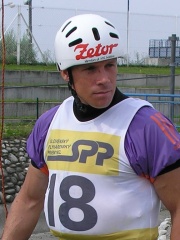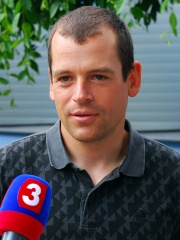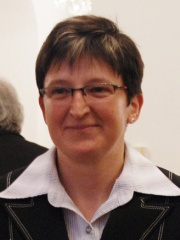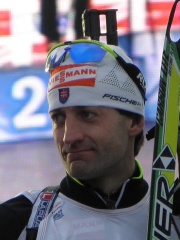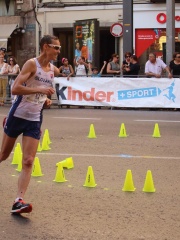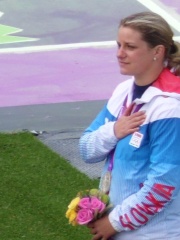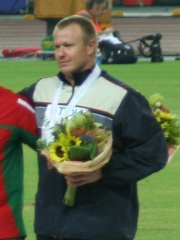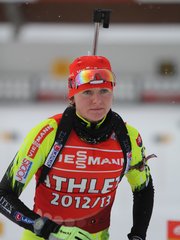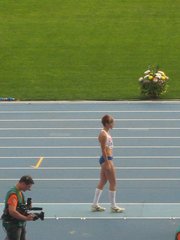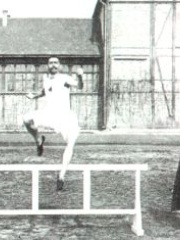
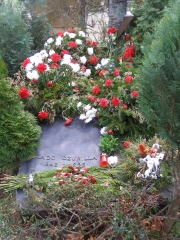
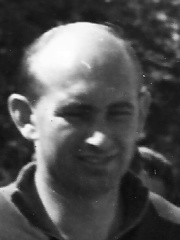
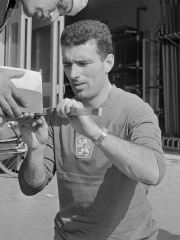
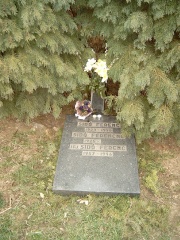
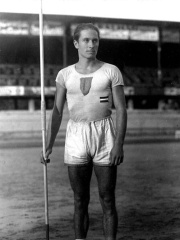
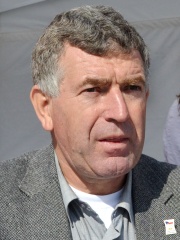

The Most Famous
ATHLETES from Slovakia
Top 10
The following people are considered by Pantheon to be the top 10 most legendary Slovak Athletes of all time. This list of famous Slovak Athletes is sorted by HPI (Historical Popularity Index), a metric that aggregates information on a biography's online popularity. Visit the rankings page to view the entire list of Slovak Athletes.

1. Alajos Szokolyi (1871 - 1932)
With an HPI of 64.27, Alajos Szokolyi is the most famous Slovak Athlete. His biography has been translated into 28 different languages on wikipedia.
Alajos János Szokolyi (also referred to as Alajos Szokoly, Hungarian pronunciation: [ˈɒlɒjoʃ ˈsokoji]; Slovak: Alojz Sokol; 19 June 1871 – 9 September 1932) was a Hungarian athlete, sports organizer, sports manager, archivist and physician. He competed at the 1896 Summer Olympics, winning the bronze medal in 100 metres dash. In the same year he also won the first ever edition of the Hungarian Athletics Championships in 100 yards dash.

2. Vladimír Dzurilla (1942 - 1995)
With an HPI of 61.64, Vladimír Dzurilla is the 2nd most famous Slovak Athlete. His biography has been translated into 20 different languages.
Vladimír Dzurilla (2 August 1942 in Bratislava, Slovakia – 27 July 1995 in Düsseldorf, Germany) was a Slovak ice hockey goaltender playing for Czechoslovakia. Dzurilla, a refrigerator repairman by profession, was goalie for the Czechoslovak national team for over 16 years, winning three gold, three silver and four bronze medals at world championships as well as one silver and two bronze Olympic medals. However, in most of these tournaments Dzurilla and Jiří Holeček were battling to be Czechoslovakia's top goaltender and each were given their share of games. For North American fans, he is mostly known for stopping 29 shots in a 1-0 win over Canada in the 1976 Canada Cup (where the Czechoslovaks finished second). Dzurilla was inducted into the International Ice Hockey Federation Hall of Fame in 1998. He suffered a fatal heart attack at his home in Düsseldorf, Germany, on 27 July 1995, only days before his 53rd birthday.

3. Imre Németh (1917 - 1989)
With an HPI of 60.62, Imre Németh is the 3rd most famous Slovak Athlete. His biography has been translated into 28 different languages.
Imre Németh (23 September 1917 – 18 August 1989) was a Hungarian hammer thrower. Németh was born in Kassa, Hungary (now Košice, Slovakia) in 1917. He won the gold medal at the 1948 Summer Olympics in London, Great Britain. He returned four years later to defend his title at the 1952 Summer Olympics held in Helsinki, Finland but failed, only managing to finish third for the bronze medal. Németh broke the world record on three occasions. On 14 July 1948 he threw 59.02 metres, beating Erwin Blask's official record from 1938 by two centimetres. (However, this was still inferior to Pat O'Callaghan's unratified record of 59.56, dating back to 1937.) On 4 September 1949 Németh improved the world mark to 59.57, beating both the official and the unofficial record. Finally, on 19 May 1950 Németh threw 59.88 m in Budapest. Némethwon the British AAA Championships title in the hammer throw event at the 1947 AAA Championships and 1949 AAA Championships. Németh died in Budapest in 1989. His son, javelin thrower Miklós Németh, also won an Olympic gold medal.

4. Pavel Schmidt (1930 - 2001)
With an HPI of 58.98, Pavel Schmidt is the 4th most famous Slovak Athlete. His biography has been translated into 16 different languages.
Pavel Leo Edmund Schmidt (9 February 1930 – 14 August 2001) was a Slovak rower who competed for Czechoslovakia, mostly in the double sculls together with Václav Kozák. They won a gold medal at the 1960 Summer Olympics in Rome and two medals at European championships in 1959 and 1961, and placed fourth at the 1962 World Rowing Championships. After retiring from competitions, Schmidt became a rowing coach, and in 1967–68 trained the Mexico national team. After that he did not return to Czechoslovakia, but settled in Switzerland together with his family. There he worked as a psychiatrists and as a coach at the Biel sports school.
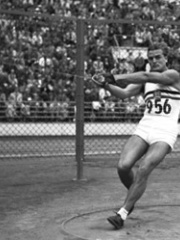
5. József Csermák (1932 - 2001)
With an HPI of 57.93, József Csermák is the 5th most famous Slovak Athlete. His biography has been translated into 22 different languages.
József Csermák (14 February 1932 – 12 January 2001 in Tapolca) was a Hungarian hammer thrower. He won the gold medal at the 1952 Summer Olympics with a throw of 60.34 m, setting a new world record and becoming the first athlete to break the 60 m barrier. At the next Olympics Csermák was chosen as the Olympic flag bearer for Hungary, but placed only fifth. He failed to reach the final at the 1960 Olympics. Besides his 1952 Olympic gold medal, Csermák won four Hungarian titles and a bronze medal at the 1954 European Championships. Csermák won the British AAA Championships title in the hammer throw event at the 1954 AAA Championships.

6. Ferenc Sidó (1923 - 1998)
With an HPI of 56.58, Ferenc Sidó is the 6th most famous Slovak Athlete. His biography has been translated into 15 different languages.
Ferenc Sidó (18 April 1923 in Pata – 6 February 1998 in Budapest) was a Hungarian international table tennis player. He was born in an ethnic Hungarian family in present-day Slovakia.

7. Béla Szepes (1903 - 1986)
With an HPI of 54.49, Béla Szepes is the 7th most famous Slovak Athlete. His biography has been translated into 17 different languages.
Béla Miklós Szepes (né Strauch; 5 September 1903 – 20 June 1986) was a Hungarian skier, athlete, graphic designer and journalist. He competed at the 1924 Winter Olympics and won the silver medal in the javelin throw in the 1928 Summer Olympics. He captured seven Hungarian Athletics Championships and three British Athletics Championships titles. Later Szepes had a successful career as a graphic artist, becoming an influential sports cartoonist in Hungary.

8. Imrich Bugár (b. 1955)
With an HPI of 52.55, Imrich Bugár is the 8th most famous Slovak Athlete. His biography has been translated into 21 different languages.
Imrich Bugár (Hungarian: Bugár Imre, born 14 April 1955) is a Czechoslovak discus thrower. An ethnic Hungarian who represented Czechoslovakia and then the Czech Republic, his career highlights include an Olympic silver medal from 1980, a European Championship title from 1982 and a gold medal in the inaugural World Championships in 1983. His personal best throw of 71.26 metres puts him tenth in the all-time performers list.

9. Jozef Pribilinec (b. 1960)
With an HPI of 52.27, Jozef Pribilinec is the 9th most famous Slovak Athlete. His biography has been translated into 23 different languages.
Jozef Pribilinec (Slovak pronunciation: [ˈjɔzef ˈpribiliɲets]; born 6 July 1960) is a Slovak track and field athlete who mainly competed in racewalking. He was born in Kopernica. Pribilinec competed for the former Czechoslovakia at the 1988 Summer Olympics held in Seoul, South Korea where he won the gold medal in the men's 20 kilometre walk event. He represented Czechoslovakia for most of his career and in addition to his Olympic gold, won two silver medals at the World Championships in Athletics (1983 and 1987) and one gold and one silver at the European Athletics Championships for his country. He was a two-time champion at the European Athletics Indoor Championships, winning in 1987 and 1988 over distances of 3000 m and 5000 m, respectively. He was a four-time participant at the IAAF World Race Walking Cup and his best performance was a win over 20 km at the 1983 IAAF World Race Walking Cup, becoming his country's first victor at the competition. He had previously shown his developing talent as a youngster with a win at the 1979 European Athletics Junior Championships. His personal best time of 1:19:30 hours for the 20 km race was a world record from 24 September 1983 to 3 May 1987. This continued a tradition of Czechoslovak record holders, following in the steps of Václav Balšán and Josef Doležal. Before retiring, he represented Slovakia at the 1993 World Championships in Athletics, placing 17th in the men's 20 km walk.

10. Dušan Pašek (1960 - 1998)
With an HPI of 51.90, Dušan Pašek is the 10th most famous Slovak Athlete. His biography has been translated into 15 different languages.
Dušan Pašek (1960 – 1998) was a Czechoslovak and Slovak professional ice hockey forward who played 48 games in the National Hockey League with the Minnesota North Stars. The rest of his career, which lasted from 1977 to 1993, was mainly spent with Slovan Bratislava in the Czechoslovak Extraliga. He won a silver medal at the 1984 Winter Olympics and represented Czechoslovakia at three Canada Cups. He also won a gold medal at the 1985 World Ice Hockey Championships. Pašek was president of the Slovak Ice Hockey Federation when he died.
People
Pantheon has 60 people classified as Slovak athletes born between 1871 and 2001. Of these 60, 52 (86.67%) of them are still alive today. The most famous living Slovak athletes include Imrich Bugár, Jozef Pribilinec, and Michal Martikán. The most famous deceased Slovak athletes include Alajos Szokolyi, Vladimír Dzurilla, and Imre Németh. As of April 2024, 6 new Slovak athletes have been added to Pantheon including Juraj Minčík, Michal Riszdorfer, and Rastislav Staňa.
Living Slovak Athletes
Go to all RankingsImrich Bugár
1955 - Present
HPI: 52.55
Jozef Pribilinec
1960 - Present
HPI: 52.27
Michal Martikán
1979 - Present
HPI: 47.76
Pavol Hochschorner
1979 - Present
HPI: 46.25
Elena Kaliská
1972 - Present
HPI: 46.13
Pavol Hurajt
1978 - Present
HPI: 45.67
Peter Hochschorner
1979 - Present
HPI: 45.57
Danka Barteková
1984 - Present
HPI: 44.20
Matej Tóth
1983 - Present
HPI: 44.05
Slavomír Kňazovický
1969 - Present
HPI: 43.27
Zuzana Rehák-Štefečeková
1984 - Present
HPI: 42.90
Libor Charfreitag
1977 - Present
HPI: 42.49
Deceased Slovak Athletes
Go to all RankingsAlajos Szokolyi
1871 - 1932
HPI: 64.27
Vladimír Dzurilla
1942 - 1995
HPI: 61.64
Imre Németh
1917 - 1989
HPI: 60.62
Pavel Schmidt
1930 - 2001
HPI: 58.98
József Csermák
1932 - 2001
HPI: 57.93
Ferenc Sidó
1923 - 1998
HPI: 56.58
Béla Szepes
1903 - 1986
HPI: 54.49
Dušan Pašek
1960 - 1998
HPI: 51.90
Newly Added Slovak Athletes (2025)
Go to all RankingsJuraj Minčík
1977 - Present
HPI: 42.41
Michal Riszdorfer
1977 - Present
HPI: 40.13
Rastislav Staňa
1980 - Present
HPI: 39.77
Radoslav Židek
1981 - Present
HPI: 37.76
Jana Daubnerová
1984 - Present
HPI: 37.70
Dana Velďáková
1981 - Present
HPI: 35.55
Overlapping Lives
Which Athletes were alive at the same time? This visualization shows the lifespans of the 8 most globally memorable Athletes since 1700.

